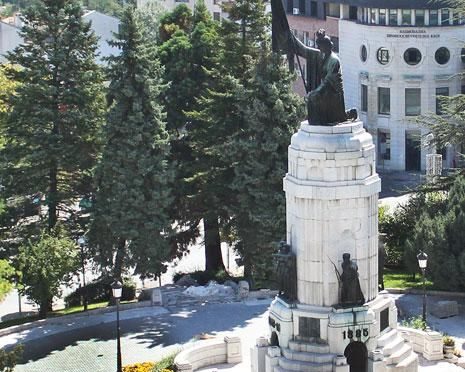

Mother Bulgaria Monument lies in the city center of Veliko Tarnovo.
It was built in memory of 21 officers, 24 petty officers and 62 soldiers died in the Russo-Turkish War in 1877-1878, Serbo-Bulgarian War in 1885, Balkan wars in 1912-1913 an the First World War in 1914-1918. The funds for its construction were collected from donations by citizens of Veliko Turnovo.
The beginning of the monument construction is placed on the central idea that on March 9, 1926, at the initiative of ”Bunar Hisar”, The Reserve Officers Society is set up a commitee to raise up a monument of all fighters who have fallen for liberation and unification of Bulgarian tribe. The place was chosen in the center of Mara’s Field and the Municipal Council gave up the land.
Svetoslav Yotzov, the sculptorfrom Vratsa City has designed a three-storey monument, built in marble and bronze. There is an ossuary at its base with four entries and stairs leading to it. Above the entrance are engraved the years of wars for liberation and unification of the Bulgaria country. Between them lie four bronze reliefs illustrating important moments of the war. Four bronze figures of soldiers and officers with military uniforms, equipment and weapons typical for that time are located at the second level. At the top of the monument is a bronze figure of a woman kneeling, symbolizing the “Mother Bulgaria” the crown on his head and a flag in his right hand. The monument is surrounded by a fence in relief, in solid marble, which is crossed on its four sides by marble stairs.
The pedestal on one side is of 14.30 meters and its height is of 18.50 meters. Implementation of the building is the work of no less authoritarian, in the past- the architect Tenyo Ibushev from Kazanlak City.
Elaboration of the complex composition of figures is the work of Vania Rafael, a mingled from Budapest. Metal fence, which still there, has been designed by the famous Leon Filipov from Tarnovo City.
The inauguration of the monument is made on May 6, 1935.
In the 1936s, Anton Jan Novak (designer of Old Garden in the city and Grand Garden in Varna) makes the total afforestation of the garden with a total of eighteen species of shrubs and thirteen rare species of trees. Novak succesfully experimented with Indian Lagerstroemia plant, he plants spruce, larch, konkolor, yew tree, mimosa, sequoia, Californian cedar, Chinese meadow sweet, magnolia, which even today enjoys eyes.
During the Russo-Turkish Liberation War, there was a Turkish fortress in this place called (Tabia), where the turks used to stop on the Belyakovsko Road in the direction of Russian troops.The Russians replied to cannonade and once destroyed a cannon, the Turks fled and abandoned other three cannons.
After unification in 1885, the city’s westward expansion instead of the current monument continues with a differentiated market (Sir Market), where every Friday were sold a lot of fruits and vegetables. The most notable place was the place of sale of watermelons, which had been brought from the surrounding villages, in huge quantities. Most of the sweet melons were from the Nikyup village.The mellons were also sold by piece, and the richest were buying full carts. The market was very beautiful in autumn, when the huge piles of vegetables in all colors were filled. Inwards, (where now is the The Mara’s Field Park ) was the wood and birds market. Sometimes there were so many birds that they were sold extremely cheap jus to avoid bringing them back to the village.
Today, around the memorial complex is build a garden with flowers and benches.
It was built with funds donated by the people of Veliko Tarnovo city. Mother Bulgaria is one of the symbols of Veliko Turnovo.
Over the years, in the socialist Bulgarian, the facade of the monument doesn’t change to much, except for the crown, which as a symbol of the monarchy has been removed from the head of the female figure. Later after the year of 1989 the crown has been put back in its place, and in 2000 in the ossuary of the monument an eternal flame burns, lit by generations of grateful people of the city’s old capital.
